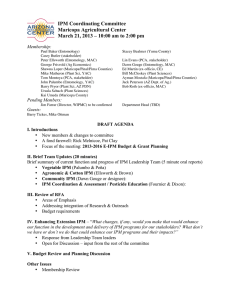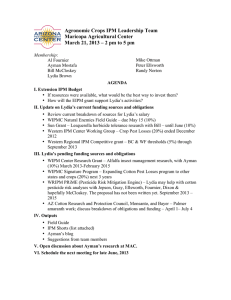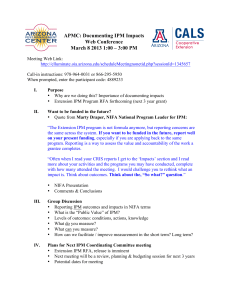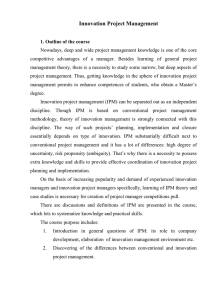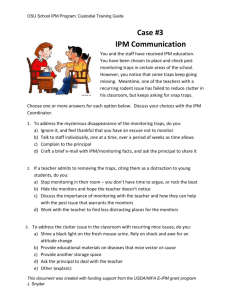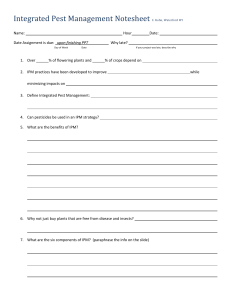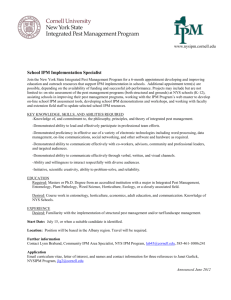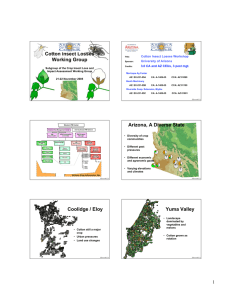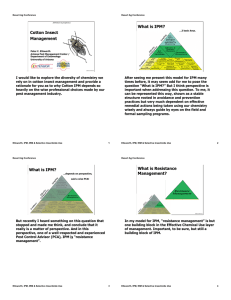Time for Tough Talk Arizona Pest Management Center – Examine our infrastructure
advertisement
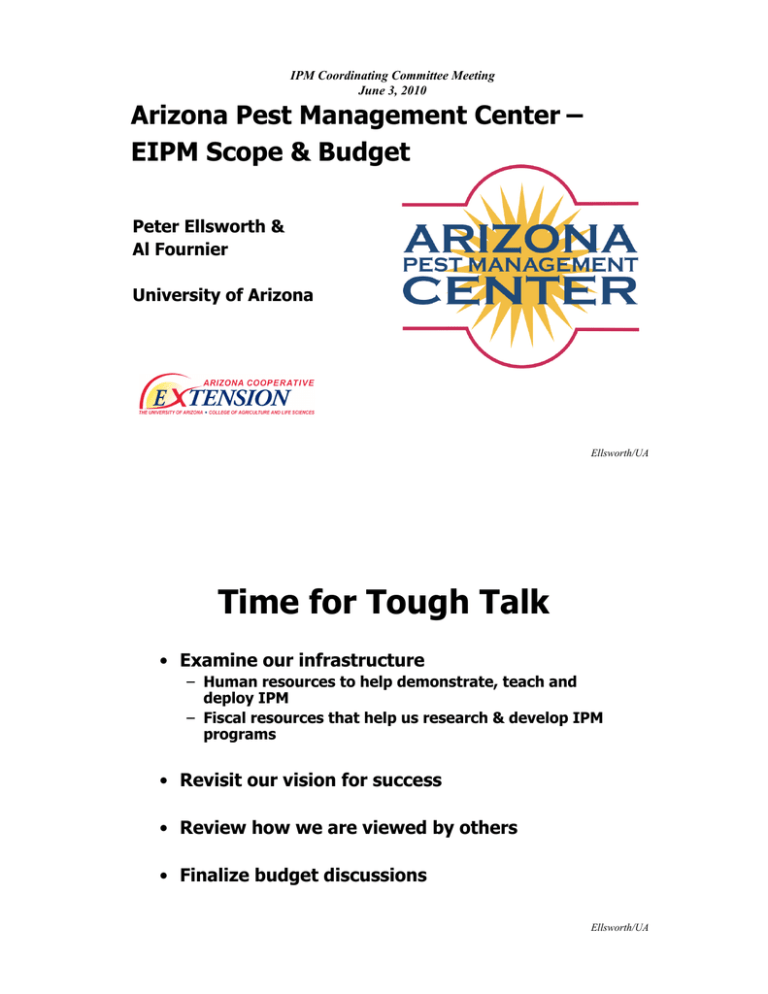
IPM Coordinating Committee Meeting June 3, 2010 Arizona Pest Management Center – EIPM Scope & Budget Peter Ellsworth & Al Fournier University of Arizona Ellsworth/UA Time for Tough Talk • Examine our infrastructure – Human resources to help demonstrate, teach and deploy IPM – Fiscal resources that help us research & develop IPM programs • Revisit our vision for success • Review how we are viewed by others • Finalize budget discussions Ellsworth/UA Goal • Our goal is to increase the ability of Arizona citizens and professional pest managers to put IPM knowledge into practice in diverse environments, with the end result of reducing environmental, human health and economic risks to end-users. Ellsworth/UA Approach • Through this grant, we will enhance local “on-the-ground” outreach through the deployment of additional personnel resources (Extension Assistants) specifically dedicated to supporting IPM demonstration, outreach, implementation and evaluation. This will synergize our existing capacity to conduct translational research and outreach across major program areas statewide. Ellsworth/UA Rationale • Traditionally underfunded by formula IPM dollars • No cotton IPM funding for 30 years • Access to professional pest managers • Diverse and naïve (non-native) population • Large urban centers • Importance of tourism to the state • Large state, large but few counties – Scant local resources for EIPM Ellsworth/UA Human Resources – Counties Human Resources – EIPM (Dedicated to County support) • Dr. Al Fournier, Coordination, Assessment • Theresa Smith, Web Support • Richard Farmer, Assessment / Pesticides • Marco Peña, Vegetable IPM • Barry Tickes, Weeds Extension Funds Ellsworth/UA Research Funds Ellsworth/UA Our Vision for Success • Strengthen & stabilize our IPM infrastructure • Invest in human resources critical to deployment of IPM programs • All through aggressive leveraging of other research and outreach funds Ellsworth/UA 10-fold Leverage (4 years, under formula) $4.82M Intramural Supported Engagement Infrastructure IDC $0.402M Federal 3(d) Enabled Ellsworth/UA 10-fold Leverage (4 years, under formula) $4.82M Intramural Supported Engagement Infrastructure IDC $0.706M $0.402M EIPM Federal 3(d) Enabled Ellsworth/UA Panel Review of EIPM • Strengths • Weaknesses • Bias? Ellsworth/UA Strengths – AZ-EIPM • Excellent stakeholder involvement through an existing coordinating committee • Well documented with preliminary data • Experience of personnel • Good track record of leveraging • Important producer of cotton • Diversity of programs are strengths • Program Manager’s expertise in school IPM • Probability of success is high Ellsworth/UA Weaknesses – AZ-EIPM • • • • • Minimal “trans-disciplinary involvement” Too strong dominance of entomology “Entire budget” focus on IPM coordination Much is continuation of current activities “Excessive” budget dominates negative aspects of the proposal – Program success based in intention of hiring two fulltime Assistants in Extension (37% of budget) • Consumer/urban weakest, not fleshed out • “The budget is quite high”; justification extensive Ellsworth/UA Other notables • Seems feasible, esp. due to the continuation of already-successful programs • Good deliverables and evaluation (research), in urban tree IPM, allergens in homes/schools, agronomic reduced pesticide use • PI and Co-PI specialize in entomology • Addition of pathologists/weed scientists could strengthen IPM in Arizona, but might dilute the focus of the project • “Flagship IPM in Schools program” Ellsworth/UA More… • The number of staff rivals that of some regional IPM centers. Sustainability questionable • “The state should probably be hiring extension specialists, not the IPM program.” • Hiring of two full time Assistants in Extension may be difficult (and may not be experienced) • Impact of homeowner education on tree management, not detailed but nice; same comment for Pilot Public Housing program Ellsworth/UA Synthesis Comments • “Concept gets better with a substantially reduced budget”(!!!) • “The concept of hiring state specialists [sic] should be the responsibility of permanent institutional budgets.” Ellsworth/UA Take Home Message • Comments on balance were positive wrt technical aspects of our approach • Reviewers fixated on budget & hiring of “new” personnel • Net, ratings and rankings were punitive for what was viewed as excessive budget and for what they believed was an institutional responsibility Ellsworth/UA Take Home (2) • EIPM support of staff is never likely to exceed 50%; requires partnership with teams • All creative solutions welcome – E.g., establish system for APMC harvesting portion of IDC on all “IPM” grants (precedent = Center for Insect Science) • CALS should be matching EIPM investment as well Ellsworth/UA Here’s the Deal • We need to develop our revised budget and scope of work, but… • We need to continue to acknowledge that EIPM is not a panacea for all things IPM in AZ, and • Major leveraging of programmatic and IPM project-based dollars will always be crucial… Ellsworth/UA Institutional Commitment • Future success hinged on CALS commitment, which at present is a minority stakeholder • Significant programmatic and fiscal commitment is needed • As well, IPM “teams” must develop their own plans for sustainability through aggressive leverage of extramural IPM funds, including for support of Assistants in Extension. Ellsworth/UA

